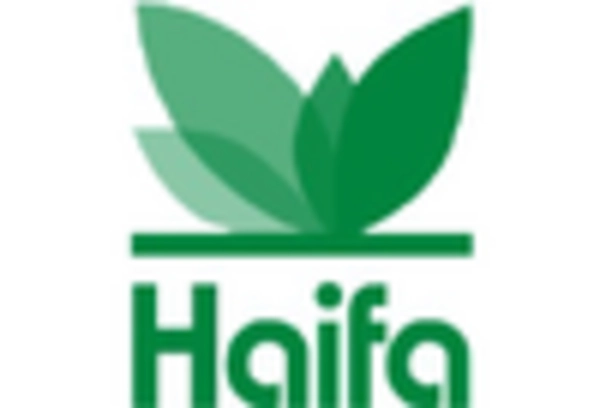Rising Demand for High-Quality Produce
The demand for high-quality produce is a significant driver of the secondary macronutrients market. Consumers are increasingly seeking fruits and vegetables that are not only visually appealing but also nutritionally rich. Secondary macronutrients play a crucial role in enhancing the quality of produce, leading to better taste, texture, and nutritional value. Market data indicates that the premium segment of the produce market has grown by approximately 20% over the past few years, with consumers willing to pay more for products that are perceived as healthier. This trend is likely to propel the secondary macronutrients market as farmers strive to meet consumer expectations.
Increasing Awareness of Nutritional Benefits
The growing awareness of the nutritional benefits associated with secondary macronutrients is driving the market. Consumers are becoming more informed about the role of these nutrients in enhancing crop yield and quality. This trend is particularly evident in the agricultural sector, where farmers are increasingly adopting practices that incorporate secondary macronutrients to improve soil health and plant growth. According to recent data, the use of secondary macronutrients has been linked to a 15% increase in crop productivity in various regions. As awareness continues to rise, the secondary macronutrients market is likely to expand, with more farmers seeking to optimize their yields through these essential nutrients.
Shift Towards Integrated Nutrient Management
The shift towards integrated nutrient management (INM) is a pivotal driver for the secondary macronutrients market. Farmers are increasingly recognizing the importance of a holistic approach to soil fertility, which includes the balanced application of secondary macronutrients alongside primary nutrients. This trend is supported by research indicating that INM can enhance soil health and crop resilience. As more agricultural stakeholders adopt INM practices, the demand for secondary macronutrients is expected to rise. Market analysts project that the INM approach could lead to a 25% increase in the utilization of secondary macronutrients over the next five years, further solidifying their role in sustainable agriculture.
Regulatory Support for Sustainable Agriculture
Regulatory frameworks in the US are increasingly supporting sustainable agricultural practices, which in turn is benefiting the secondary macronutrients market. Government initiatives aimed at promoting environmentally friendly farming methods encourage the use of secondary macronutrients as part of integrated nutrient management strategies. For instance, the USDA has implemented programs that provide financial assistance to farmers who adopt sustainable practices, including the application of secondary macronutrients. This regulatory support is expected to enhance market growth, as farmers look to comply with sustainability standards while improving their crop production.
Technological Innovations in Fertilization Techniques
Technological innovations in fertilization techniques are reshaping the secondary macronutrients market. Advances in precision agriculture, such as soil testing and nutrient management software, allow farmers to apply secondary macronutrients more effectively. These technologies enable targeted application, reducing waste and enhancing nutrient uptake by plants. As a result, the efficiency of secondary macronutrient use is improving, which could lead to a projected market growth of 10% annually. The integration of technology in farming practices is likely to continue driving the adoption of secondary macronutrients, as farmers seek to maximize their productivity and sustainability.

















Leave a Comment